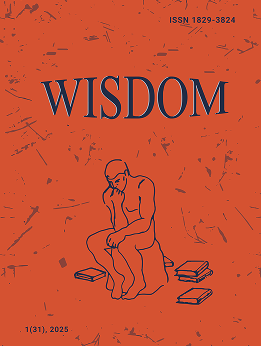Fractionalization of Unrecognized States in Europe
DOI:
https://doi.org/10.24234/wisdom.v6i1.69Keywords:
fractionalization, unrecognized statesAbstract
Aims: The data on ethnic fractionalization is out-of-date in some cases, and in the case of some countries there are no such data at all. We measure the ethnic, linguistic and religious fractionalization of unrecognized states in Europe –of Abkhazia, Northern Cyprus, Nagorno-Karabakh, Transnistria and Kosovo, which were up till now excluded from the scope of interest of fractionalization observers. Methods: Using the population census data of these countries, we measure the fractionalization with the one minus Herfindahl index. Results: Whether homogenous or heterogeneous, the levels of their fractionalization remain different. Therefore, the (non)recognition of a state has no effect on its level of fractionalization.
Downloads
References
Atlas narodov mira (Atlas of the world's peoples). 1964. Glavnoe upravlenie geodezii i kartografii gosudarstvennogo geologicheskogo komiteta SSSR institute Etnografii im. N.N.Miklukho-Maklaya. Moskva.
Blakkisrud, H., Kolstø, P. (2008). “Living with Non-recognition: State- and Nation-building in South Caucasian Quasi-states.” Europe-Asia Studies 60 (3): 483-509.
Blakkisrud, H., Kolstø, P. (2011). “From Secessionist Conflict Toward a Functioning State: Processes of State- and Nation-Building in Transnistria.” Post-Soviet Affairs 27 (2): 178-210.
Blakkisrud, H., Kolstø, P. (2012). “Dynamics of de facto statehood: the South Caucasian de facto states between secession and sovereignty.” Southeast European and Black Sea Studies 12 (2): 281-298.
Blakkisrud, H., Kolstø, P. (2012). “De facto states and democracy: The case of Nagorno-Karabakh.” Communist and Post-Communist Studies 45 (1-2): 141-151.
Bolshakov, A., Mansurov, T. (2013). “Conflicts of identities in the South Caucasus and problems of integration of the states of the region into European structures.” World Applied Sciences Journal 27: 43-47.
Bossert, W., D’Ambrosio, C. and La Ferrara, E. (2011). “A Generalized Index of Fractionalization.” Economica 78: 723–750.
Campos, N., Kuzeyev, V. “On the Dynamics of Ethnic Fractionalization.” American Journal of Political Science 51(3): 620-639.
Caspersen, N. (2012). “Unrecognized States: The Struggle for Sovereignty in the Modern International System.” Campridge: Polity.
Cederman, L.E., Girardin, L. (2007). “Beyond Fractionalization: Mapping Ethnicity onto Nationalist Insurgencies.” American Political Science Review 101: 173-185.
Fearon, J. (2003). “Ethnic and Cultural Diversity by Country.” Journal of Economic Growth 8 (2): 195–222.
Kanchan, Ch., Wilkinson, S. (2008). “Measuring the Effect of Ethnicity.” Comparative Political Studies 41: 515-563.
King, Ch. (2001). “The Benefits of Ethnic War: Understanding Eurasia's Unrecognized States.” World Politics 53 (4): 524-552.
Kolo, Ph. (2012). “Measuring a New Aspect of Ethnicity – The Appropriate Diversity Index.” Ibero-America Institute for Economic Research.University Göttingen. Discussion Papers: 221.
Laitin, D., Posner, D.N. (2001). “The Implications of Constructivism for Constructing Ethnic Fractionalization Indices.” APSA-The Comparative Politics Newsletter 12: 13-17.
Montalvo, J.G., Reynal-Querol, M. (2002). “Why Ethnic Fractionalization? Polarization, Ethnic Conflict and Growth.” UniversitatPompeuFabra, Economics Working Paper: No. 660.
Posner, D. (2004). “Measuring Ethnic Fractionalization in Africa.” American Journal of Political Science. 48 (4): 849-863.
Protsyk, O. (2012). “Secession and hybrid regime politics in Transnistria.” Communist and Post Communist Studies 45 (1-2): 175-182.
Reynal-Querol, M. (2002). “Ethnicity, political systems, and civil wars.”Journal of Conflict Resolution 46 (1): 29 – 54.
Taylor, C. and M. Hudson, (1972). World Handbook of Political and Social Indicators.
Sources of census data:
Abkhazia/ http://abkhazia.gov.ge/
Kosovo/https://ask.rks-gov.net/eng/
Nagorno-Karabakh/ http://www.stat-nkr.am/en/national-statistical-service-of-nkr
Northern Cyprus/
http://www.devplan.org/Frame-eng.html
Downloads
Published
How to Cite
Issue
Section
License
Creative Commons Attribution-Non-Commercial (CC BY-NC). CC BY-NC allows users to copy and distribute the article, provided this is not done for commercial purposes. The users may adapt – remix, transform, and build upon the material giving appropriate credit, and providing a link to the license. The full details of the license are available at https://creativecommons.org/licenses/by-nc/4.0/.















